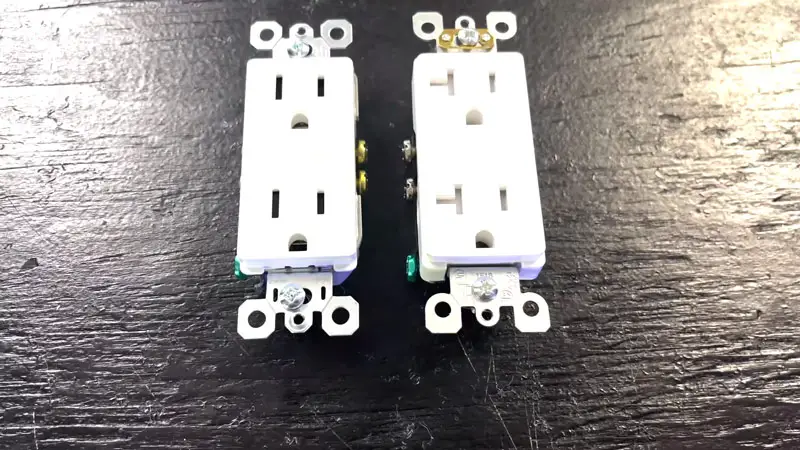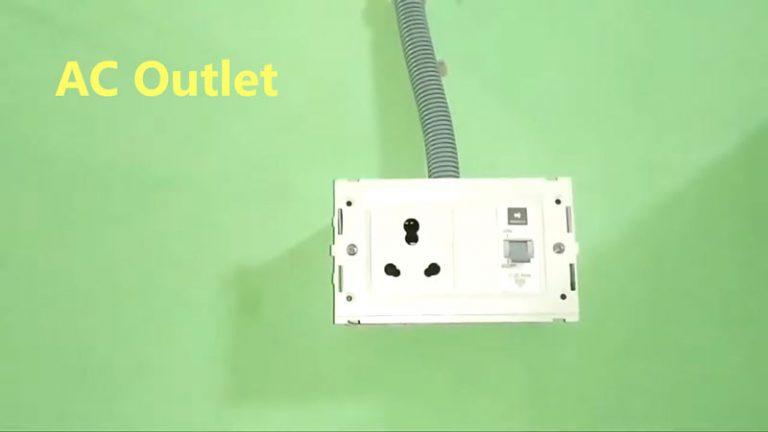What Is The Sideways Slot For On An Outlet

If your appliance needs a 20-amp plug, get one before you buy an electric cord. When buying an outlet, make sure it’s in the correct location and that the electrical cord is plugged into it correctly.
Tripping over cords can cause serious injuries – use safety straps when moving heavy objects around or unplugging devices. Follow these tips to avoid getting frustrated with appliances: know what they need and where they need it; pay attention to labels and warnings; use common sense.
You'll Learn About
What Is The Sideways Slot For On An Outlet?
Make sure all of your appliances are properly plugged into the wall – and that you have enough outlets in your kitchen. If an appliance is outdated or doesn’t have a 20-amp plug, it might be time to replace it.
In order for devices to work correctly, they need to be plugged into the correct outlet – so make sure you know which one each device uses. When unplugging appliances, try not to trip over cords or mishandle them – use safety straps when necessary.
Finally, don’t forget about preserving energy by following these simple tips while working in your kitchen.
Your Appliance Needs A 20-Amp Plug
Most appliances come with a 20-amp plug, but some may require an adapter. If you’re not sure what type of outlet your appliance needs, consult the instruction manual or contact the manufacturer for help.
Make sure to keep your plugs and cords organized by grouping them in one place so they’re easily accessible when needed. To avoid tripping over cords and loose plugs, always use a holder or rack to hang your devices while they’re charging.
Keep track of which outlets are currently in use by noting their wattage on a label or sticker.
Get A New Outlet
If your old outlet isn’t up to the task, it’s time for a new one. Look for an outlet that is sideways or offset in order to maximize space in your wall socket and save valuable countertop real estate.
Choose an outlet with a higher amperage so you can power more devices at once without overloading the circuit breaker box. Make sure the electrical code requirements are met before installation by checking with your local utility company or contractor.
It’s also a good idea to test out each device before connecting it to the new outlet – just in case there have been any changes made since your last repair.
Check The Electrical Cord
Make sure that the outlet you’re using is compatible with your appliance by looking for a sideways slot. If the outlet doesn’t have a sideways slot, use an adapter to make it work.
If there’s still no luck, consult your appliance manufacturer to see if they offer a specific cord-sizing option. Sometimes wall outlets are too high or low for some appliances and need to be relocated or replaced altogether in order to accommodate them properly.
The easiest way to verify that everything is connected correctly is by testing the power source with an extension cord.
Avoid Tripping Over Cords When Unplugging Devices
To avoid tripping over cords when unplugging devices, place the outlet sideways on a wall near where you will be using it. This way, you won’t have to bend down to plug in your devices and can easily see what is plugged into the outlet.
If possible, try to use an extension cord if needed so that you don’t have to reach across multiple cords for one device. Make sure all of your plugs are properly aligned when plugging them in – this will help prevent any potential power strips from being accidentally turned off by accident or movement.
Use Safety Straps When Moving Heavy Items
When moving heavy items, use safety straps to keep them secure. Make sure the outlet is properly aligned before plugging in your appliance; otherwise, you could end up with a sideways slot.
Use a T-bar adapter if needed to get the right fit on your outlet and avoid any damage to it or your furniture. If space is an issue, consider using extension cords when moving large appliances across rooms or changing outlets in the home office.
Why do outlets have a sideways slot?
An outlet on a wall or floor has a sideways slot to help it fit in tight spaces. This slot makes it easier for you to plug in your device and keeps the cord out of the way.
Wider Slots Help Prevent Contact
When you plug in an appliance, the wider slots on the outlet make it more difficult for metal pieces to come into contact with electrical cords. This prevents sparks from occurring which could damage your device or even start a fire.
Reduces the Chance of a Cord Getting Snapped
The slot orientation also helps reduce the chance of something getting caught on one of the screw tabs and being pulled out, potentially causing injury.
Screws Are Isolated From Each Other
If you need to separate two outlets so that they can’t share power anymore (for example if there’s too much voltage coming through them), all you have to do is remove one of the screws located at either end of each outlet and they will be easily separated.
It’s also worth noting that these screws are isolated from each other by a tab, meaning that once removed they cannot be put back together without some additional effort – making them easy to dispose of when necessary.
What are the slots on an electrical outlet?
An electrical outlet has a series of small slots on the backside. These slots are designed to accept plug-in devices, like phones and computers. When you plug in your device, the outlet detects it and opens up the appropriate connection wire inside the wall.
The slots on an electrical outlet are designed to allow electricity to flow freely through the outlet. This is important because it allows you to use your electrical devices safely and without any problems. If you have a broken pipe in your home, water may be leaking into your home’s wiring system and causing various electrical problems including cold showers and blown fuses.
To unblock a sink drain, often all you need is some plunger suction and a bucket or tub of hot water. Once the drain has been cleared, pour some boiling water down the drain to seal it off again. Sometimes when there’s something blocking the openings on an electric outlet (like debris).
All you need is a screwdriver to pop open those pesky screws.
Why are there upside down outlets?
There’s an upside-down outlet in the wall because someone switched it out while cleaning around the electrical box. Pets may have gotten into the electrical box and pulled the wire out of the receptacle, or someone else installed or changed outlets without notifying you first.
When there is a switch on an outlet that has been flipped, sometimes we can’t tell just by looking at it. Sometimes when people touch switches they make them flip unintentionally. This could be what happened to you if you touched a switch while wiping down your surroundings.
If something seems fishy with any of your outlets and you don’t know how they got like that, consult with a professional before making any changes yourself.
What is the third pin of an outlet for?
The third pin of an outlet is the one that connects to the power supply. It’s usually blue, green, or yellow in color and has a screw on top.
The third pin of an outlet is used to provide safety and keep the circuit open.
This pin helps protect people and property from electric shock, which can occur if there is a loss of power on the cord. Older plug designs have a third prong while newer designs don’t. Adapter plugs use a screw to secure this pin in place, which allows for more versatile installation options.
Is it code to install outlets upside down?
It’s not always clear which way outlets should be installed, but the correct orientation is typically indicated by a symbol on the outlet. If you’re unsure of what this symbol looks like, or if you’re still having trouble finding the right outlet placement, please contact your electrician for assistance.
There is no code requirement that says an outlet receptacle should be installed one way or the other. In fact, some manufacturers actually recommended the orientation that many of us view as upside down—with the round grounding slot at the top. The round grounding hole on an outlet receptacle can provide a more secure connection to your home’s electrical system.
If you want to install your outlets in a particular direction, there is no law against it.
Why are there 2 holes at the end of electrical plugs?
The holes at the end of an electrical plug are there to prevent slips and ensure good contact between the plug and outlet. If your plugs or cords aren’t tight enough, they may fall out of the outlet. This issue can be fixed by tightening them up or replacing cords altogether.
You might encounter this problem if outlets in your home aren’t securely fastened down. You can fix it by either fixing loose screws or securing outlets tightly with cable ties. If a card falls off often, it might be because its weight is pulling it away from the screw that holds it onto the outlet.
In these cases, you could try using a lighter chord to see if that resolves the situation (though heavier chords will still work).
Lastly, sometimes people find issues with their cords after being plugged in for prolonged periods of time – one solution is to unplug completely and let your devices rest for a few hours before re-connecting; alternatively, get new cords that are specifically designed for charging electronics on the go.
To Recap
An outlet can have a sideways slot, which is used to help guide the plug into the outlet. The sideways slot prevents damage to the cord when it’s plugged in and pulled out quickly.
The sideways slot on an outlet, often referred to as the neutral slot, is designed to accommodate polarized plugs. This ensures that the plug is inserted correctly, reducing the risk of electrical shock. The wider slot connects to the neutral wire, while the narrower slot connects to the hot wire.
If you’re curious about other electrical components, you might find it interesting to learn why Mastertech air conditioners are a good brand. Additionally, understanding what E5 means on a Hisense air conditioner can help you troubleshoot common issues. For more insights, check out Toro Hypr Oil 500 substitutes.

